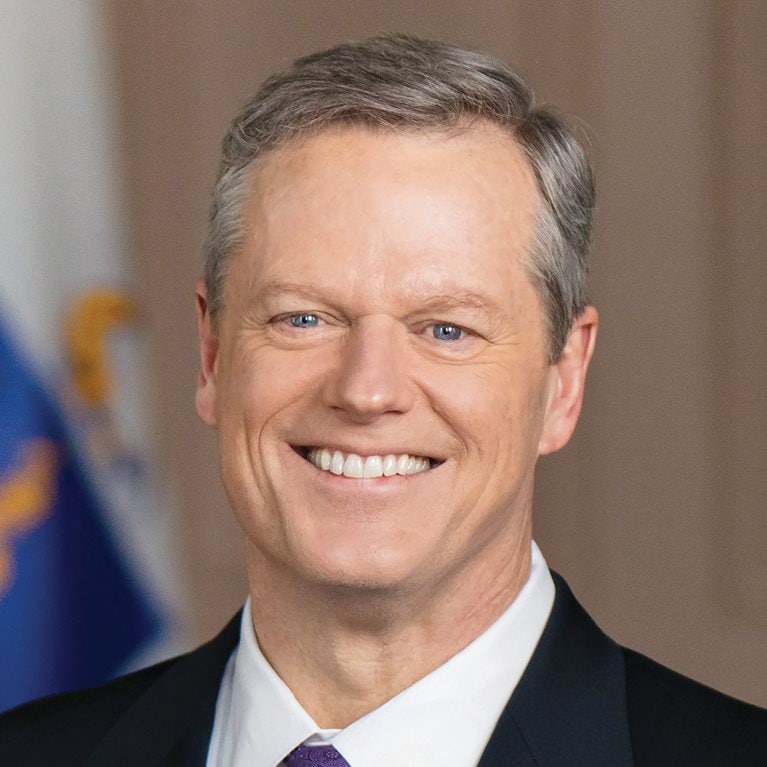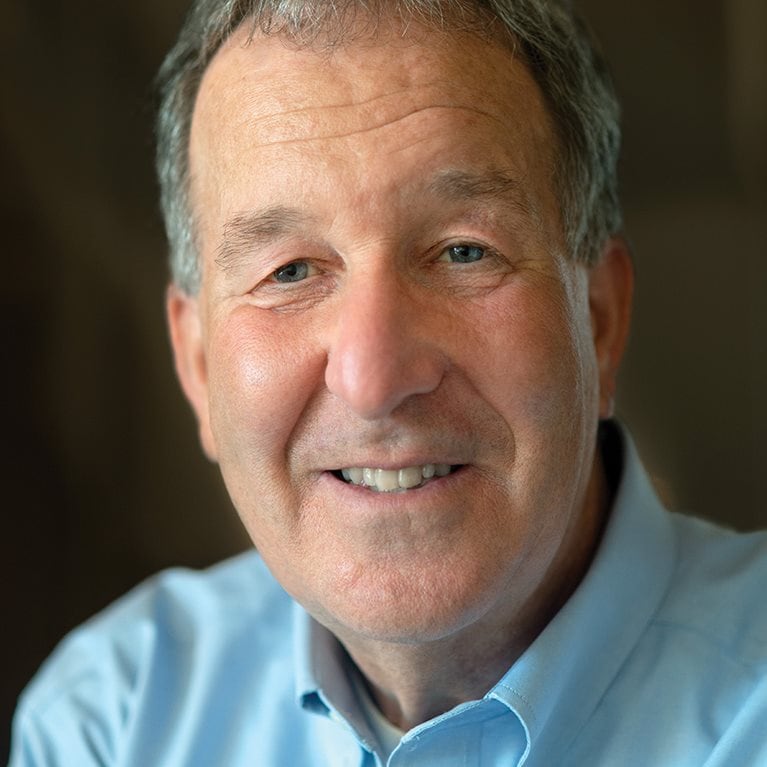Massachusetts Governor Charlie Baker is a lifelong Republican. Steve Kadish is a lifelong Democrat. While that pairing may conjure images of partisan brawls and political scorecards, the two have been joining forces for decades to tackle tough problems, execute change, and deliver results for the people of Massachusetts.
They first worked together in state government back in the 1990s, and later in the private sector when Kadish helped then-CEO Baker lead a successful turnaround of Harvard Pilgrim Health Care. In 2015, a newly elected Governor Baker tapped Kadish as his first chief of staff.
During his two terms leading the “blue” state of Massachusetts, Governor Baker—who did not seek reelection—has consistently ranked among the most popular governors in the United States.1
Together, he and Kadish developed a four-step framework that they have now written about in their new book, Results: Getting Beyond Politics to Get Important Work Done (Harvard Business Review Press, March 2022). The two sat down recently with McKinsey executive editor Patricia Sabga to talk about how they applied that framework to master challenges that many state governments face, from turning around underperforming agencies to ensuring government stays focused on its mission of delivering for the people. Their discussion has been edited for clarity and brevity.
Patricia Sabga: You two come from very different backgrounds and different sides of the political spectrum. Has there ever been a time when that partisan divide has surfaced in your work together and you’ve had to move past it?
Steve Kadish: You know, Patricia, I can honestly say, “no,” and I think it’s because, although we come at things from a different life and professional–educational experience, it’s always been about trying to figure out, “What is the problem in front of us?” And then, “How do you tackle that?” I’m a Democrat, the governor is a Republican, and he asked me to be his chief of staff.
Governor Charlie Baker: Not only was he a Democrat, he also didn’t work on my campaign. And it’s pretty unusual for a governor, or a senator, or any other elected official when they take office to pick as their chief aide someone who wasn’t actually involved in their campaign at all. And the reason I picked Steve is because campaigns are campaigns, but governing is supposed to be about the work.
Patricia Sabga: So why did you decide to write this book now?
Governor Charlie Baker: Well, Steve and I started talking about this in 2017, so it took us a long time to get there. From our point of view, the big opportunity was to do something using real-life examples that would create a framework for people in the public sector and the nonprofit sector. The “how” piece often gets lost in the way we teach government. We teach people about the “what”; we teach people about the “why”; we teach people about the history, the debates, the politics, and the policy. We don’t often spend a lot of time talking about or teaching the “how.” And the reason the “how” matters, especially in this day and age, is we need to be cognizant that if we don’t do a good job of actually delivering on the things we commit to, the message we send about government generally is that “it doesn’t work.” And there’s plenty of negativity that will always be out there. There will always be media narratives that drive it in a particular direction. But the day-to-day-to-day response and experience that people have with government is really important for a democracy to succeed.

Patricia Sabga: Let’s drill down into your four-part framework. Can you walk us through part one: “People are policy”?
Governor Charlie Baker: A lot of people think sometimes that the people in the public sector are “just there.” And there’s this tendency for people to think of them as interchangeable. The downside to that—and it’s a big downside—is that creating the right kind of leadership team means recognizing, in many cases, that certain people are good at certain things and certain people are good at other things. It’s really important to create what I would describe as a team-based approach to the way you do a lot of the work and try to build a team that has the constellation of skills you’re looking to incorporate into whatever task it is you’re trying to pursue.
A lot of times, people in elective office fill positions based on other concerns. Putting Steve Kadish in as my chief of staff was very different than the kind of person who would normally get that job. And, for me, the message I was trying to send was that I really wanted an operations person, and I didn’t care if they were Republican or Democrat, or if they had worked on my campaign. Sometimes it’s really important, when you pick somebody, to pick them for what I would describe as the strategic and operational reasons that are going to matter most to you, and not so much to check a box, which a lot of people do in many cases.
Patricia Sabga: What about part two of your framework: “Follow the facts”? In your book, you distinguish between two types.
Steve Kadish: There were two types of things that the governor and I looked at during our first 20 years of working together off and on. There’s what we called “data evidence”—and that’s the budgets, the staffing numbers, the performance metrics, sometimes reports, and so forth. It’s the hard stuff that you can put your hands on. But you also need to understand pain points. And when you look at both the data evidence and the points of pain, the data evidence can show you trends and can show you things at a higher level. But when you hear the anecdotes and the stories of the people who are either in your organization, your partners, or who you’re trying to serve, those anecdotes become real in a very, very powerful way. And from there, we would often develop performance metrics to make sure that we were addressing those points of pain.
We would require the people who were developing solutions to problems to look at both the data evidence and the points of pain. That was really important for getting at the actual problem that you were trying to solve.
We would require our cabinet leaders and folks who were agency heads, and people who were developing solutions to problems, to look at both the data evidence and the points of pain. That was really important for getting at the actual problem that you were trying to solve—for example, rural internet in western Massachusetts. Here was a case where the governor and lieutenant governor were getting an earful, unexpected, not just about how bad, but almost …
Governor Charlie Baker: Nonexistent …
Steve Kadish: … nonexistent the internet service was in all of these communities, or how it would go down in western Massachusetts. That was an example of points of pain just screaming at us, and then [us] going back and working with the agency to figure out what they had in place. And then going back out to the 50 or so individual communities to get their perspective on the actual state program. And then, from there, making the key change to the program. As opposed to offering a one-size-fits-all program where the state tells the municipalities what to do, we offered a menu of five different ways that money, operations, and implementation could go together, and each municipality made a choice.

Patricia Sabga: Part three of your framework is “Focus on the how.” You’ve given some examples of why that is a lynchpin, but could you share one example from your book that highlights this, namely the turnaround of the Department of Children and Families?
Governor Charlie Baker: Many of the policies that drove operations and decision making at the Department of Children and Families either were old—like 20 to 25 years old or older—or had simply never been fully developed. Because, if you were going to change a policy or create a policy, you had to do it with the union. And I think a lot of people just felt that was too hard. And our view was basically, “If you don’t focus on this, you don’t get anywhere.”
We developed a pretty strong relationship with union leadership and chartered out a whole list of policies that we believed either needed to be developed or updated, given the changing nature of the families, in many cases, that were being served by the department. We then created a focused “scrum” process of intensively paced meetings several times a week with certain goals and objectives baked into everybody’s calendar. Previously, to develop a policy, these meetings typically might have happened once a month. And then doing it again the following week and the following week and the following week. And, over a reasonably short period of time, they updated or wrote eight or ten major policy changes, which are really operating principles for the department that made a huge difference in its ability to do its work in the 21st century.
Steve Kadish: It was an example of how to eat an elephant one bite at a time. But it has really transformed the way the agency works. They have a tremendous focus on the definition of the problem and a rigor about using the agile scrum methodology for attacking the problem. And these are social workers. These aren’t IT people. It’s quite remarkable, and they have embraced this methodology over and over and over again. This is not to say that there’s still not work to do at the Department of Children and Families. There’s always work to do there, but they are unafraid now when a problem arises. They know they have the ability to actually tackle new problems. And there are always going to be new problems.
Patricia Sabga: Part four of your framework is “Push for results.” How did your work in the private sector inform this step?
Governor Charlie Baker: When Steve and I got to Harvard Pilgrim, they had a project management system where they had key dates and delivery deadlines. Everything was “green” or on track, yet we knew that they had all kinds of projects that were way behind. It turned out that if they weren’t going to meet a delivery date, they just moved it, and basically said, “You know, next month we’ll talk about it again and see how it’s doing relative to the new delivery date.”
When we got there, we said, “That’s actually not the way to do this. The way to do this is to pick the delivery date you think is legitimate, because there are probably other projects that are interdependent with your delivery date. If you’re going to miss your delivery date, then you are ‘yellow.’ And if you’re going to miss it by a lot, then you’re ‘red.’ You’re not ‘green.’” We wanted an objective project status. Red was a call for help.
I think there’s always this fine moment in management leadership where you have to figure out if what you’re seeing in front of you is telling you that you need to make a small change, or a big change, or no change. Really good agencies and really good governments accept responsibility for things that aren’t quite working the way they’re supposed to, and they try to do something about it. They don’t try to cover it up. They don’t try to spin their way out of it. They just accept it. And the public, generally speaking, will like it a lot more if you say, “Yeah, this is a problem, and we need to fix it,” than if you try to dismiss it or downplay it or blame somebody else.
Really good agencies and governments accept responsibility for things that aren’t quite working the way they’re supposed to, and they try to do something about it. They don’t try to cover it up.
Patricia Sabga: You wrote the book for people who work in the public sector, but are there key lessons in it that private-sector leaders can apply to their work?
Governor Charlie Baker: Communication is way more important now than it used to be, particularly given that there is so much social media out there, which comes with its own set of ideas about what a “fact” is. If you’re in the public sector, you appreciate and understand the value and the importance of communicating. And I think the private sector probably should do more. Talk to your constituencies—your employers, your customers, the people you work with—about what you’re doing and why you’re doing it.
I think the second thing is, there’s a whole piece in this book in the “Push for results” section that talks about “measure, evaluate, adjust, and repeat.” And I hope a lot of what we’ve been saying to you about how we managed a lot of this stuff over time has been based on this idea that you should measure, you should evaluate, you should adjust if you need to, and then do it again.
This whole idea that everything is always this perfect straight line, from here to here, particularly if you’re dealing with something that’s complicated, I view that almost like mythology. The simple truth is that most of the time, the path to succeeding, in any big, complicated thing, is going to be full of twists and turns and unexpected circumstances that you didn’t see coming. And that’s a hard thing for people to get comfortable with. But, generally speaking, hard stuff doesn’t ever go quite the way you would want it to. And you need to get comfortable with that, and understand it, and appreciate that in the world we live in these days, a lot more of it, public or private, is going to land in the public domain. And you have to be willing to incorporate that into how you think about the way you plan, the way you communicate, the way you make adjustments, and the way you own up to what you’re doing.
Steve Kadish: I’m gonna say five quick things.
Governor Charlie Baker: Five? Only five?
Steve Kadish: Only five. Think about this all as part of the “how.”
You need a method for how you’re approaching your work. And it’s okay to adjust the method. You could have smart people, money, resources, and a good idea of the problem, but if you do not have a method in terms of how you’re going to implement, then you may get there, but you’re certainly not going to get there in any kind of time frame that’s efficient.
Second point: use time as a weapon. We used to look at a problem and try to identify everything possible that needed to be addressed with that problem. That meant yearslong projects. But going back to the original first set of immediate points of pain, we would set time frames to say, “What can you get done in eight to ten weeks, and what’s going to be done in two weeks?”
Point three: there’s a huge difference between managing staff and managing consultants. They’re not the same. So when you are working on the project that requires a consultant’s support, you need to be super aware of the differences in how you’re making everybody work as one.
Point four: please, please, please create a forum with leadership that is looking at the performance metrics and at the project progress results. Having the forum where these things are presented and discussed is so powerful in terms of getting to what the governor said: “measure, evaluate, adjust, repeat.”
And then, finally, point five: understand and believe in the power of the dedicated team. And that is two or three people who are 120 percent focused on a problem, not as part of a portfolio of issues, but people who are focused on the problem and address it specifically. That allows this incredible acceleration and focus on getting things done.
Patricia Sabga: You dedicated the book, “To those who believe in public service and the good it must do, and who constantly strive to deliver on its promise.” Reading that, I want to loop back to my earlier question: Why this book now?
Steve Kadish: Well, please know that we had two dedications, including one to our spouses, which we decided would be fine in the acknowledgments. We wrote the book for those men and women who, day in and day out, are really doing important work, and they’re underrecognized. It’s schmaltzy, but we wanted to write a book that could help them do their work better with the idea that, if government is working better, it really is a support of what we think of as democracy.
Governor Charlie Baker: I think for both of us, it was a little bit of a labor of love to begin with. And I think all the stuff that happened, especially around January 6, made it feel a lot more important and relevant to talk about the actual work of government delivering on its promises and its commitments on the ground. I’m a state and municipal government guy. My dad worked in two administrations in Washington, but I always felt much more drawn to the stuff that’s a little closer to home. And I do believe that that work is incredibly important and deserves to be studied and supported. And that’s a big part of what the book’s about.
McKinsey has supported the Commonwealth of Massachusetts during Governor Charlie Baker’s terms in office on topics including transportation, technology, economic development, and other areas.


